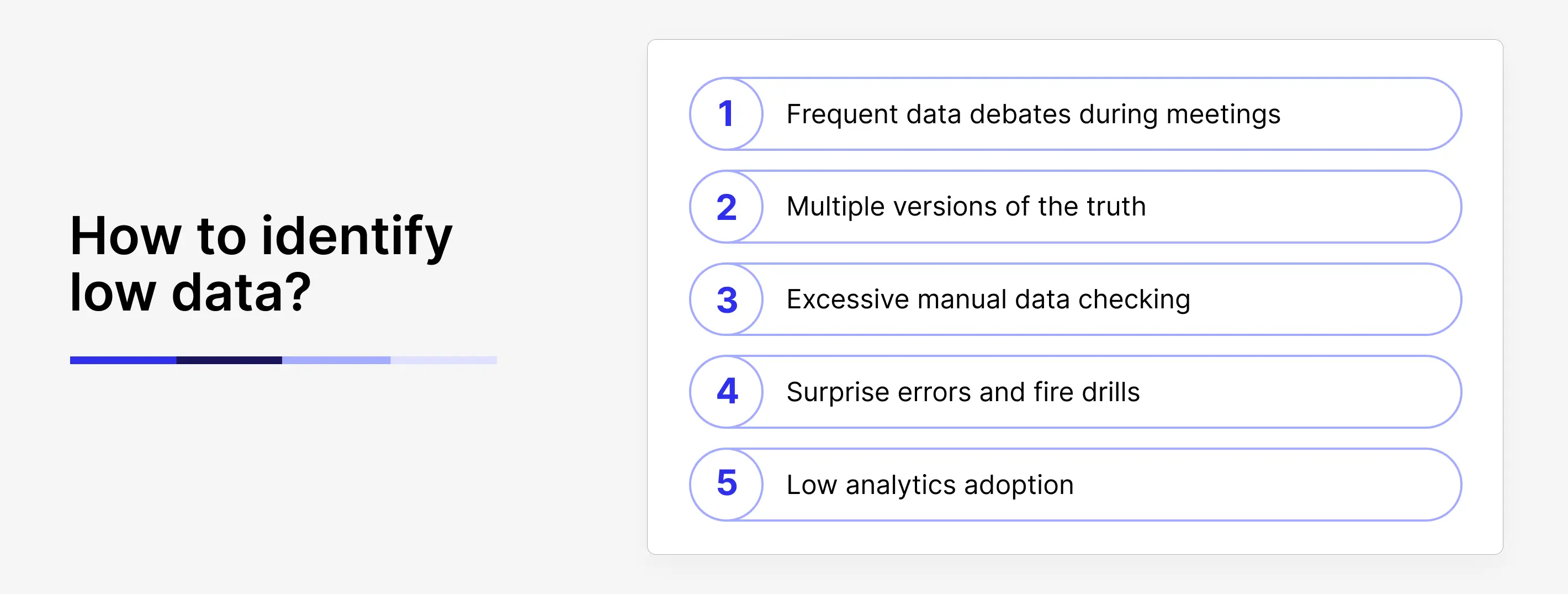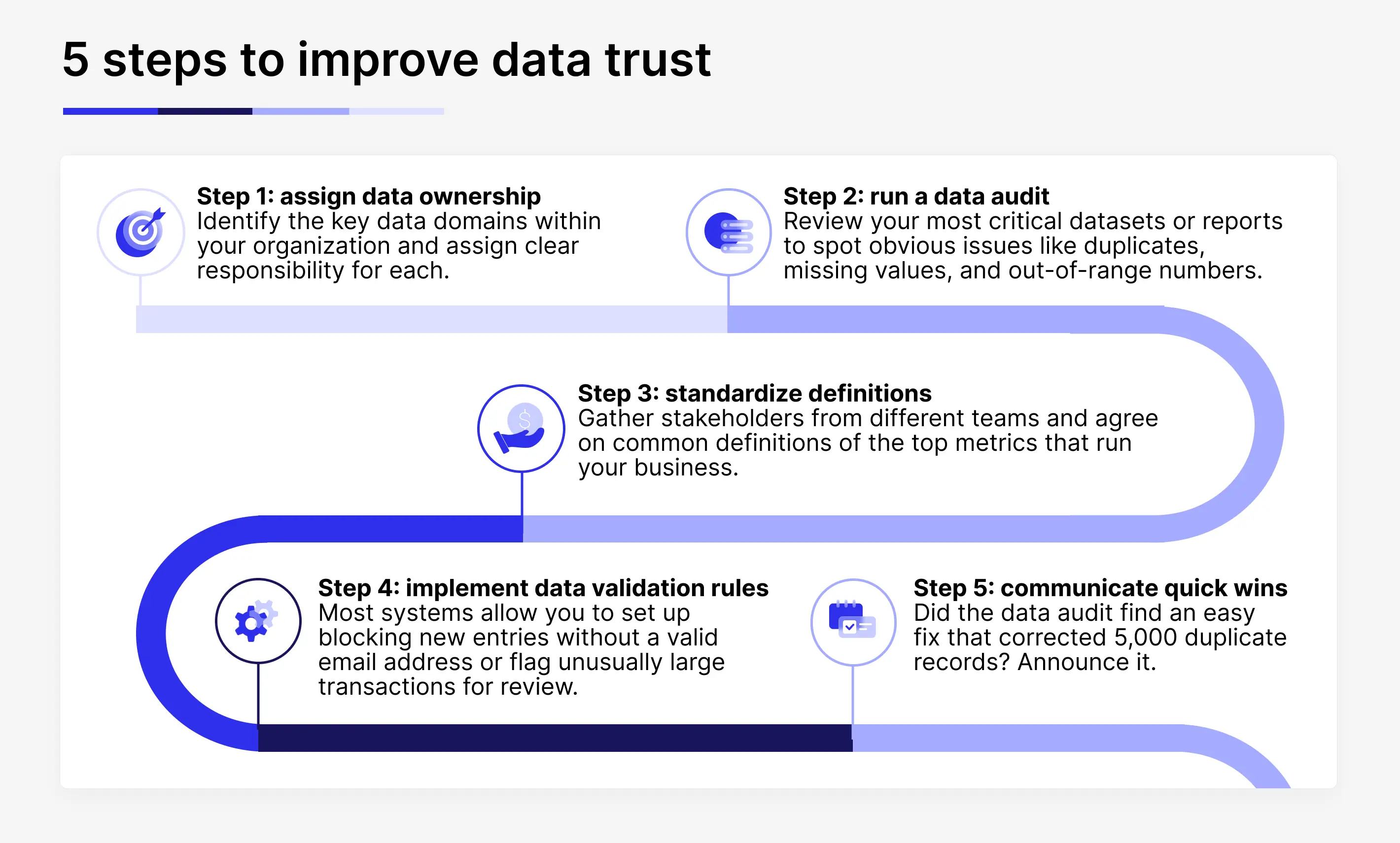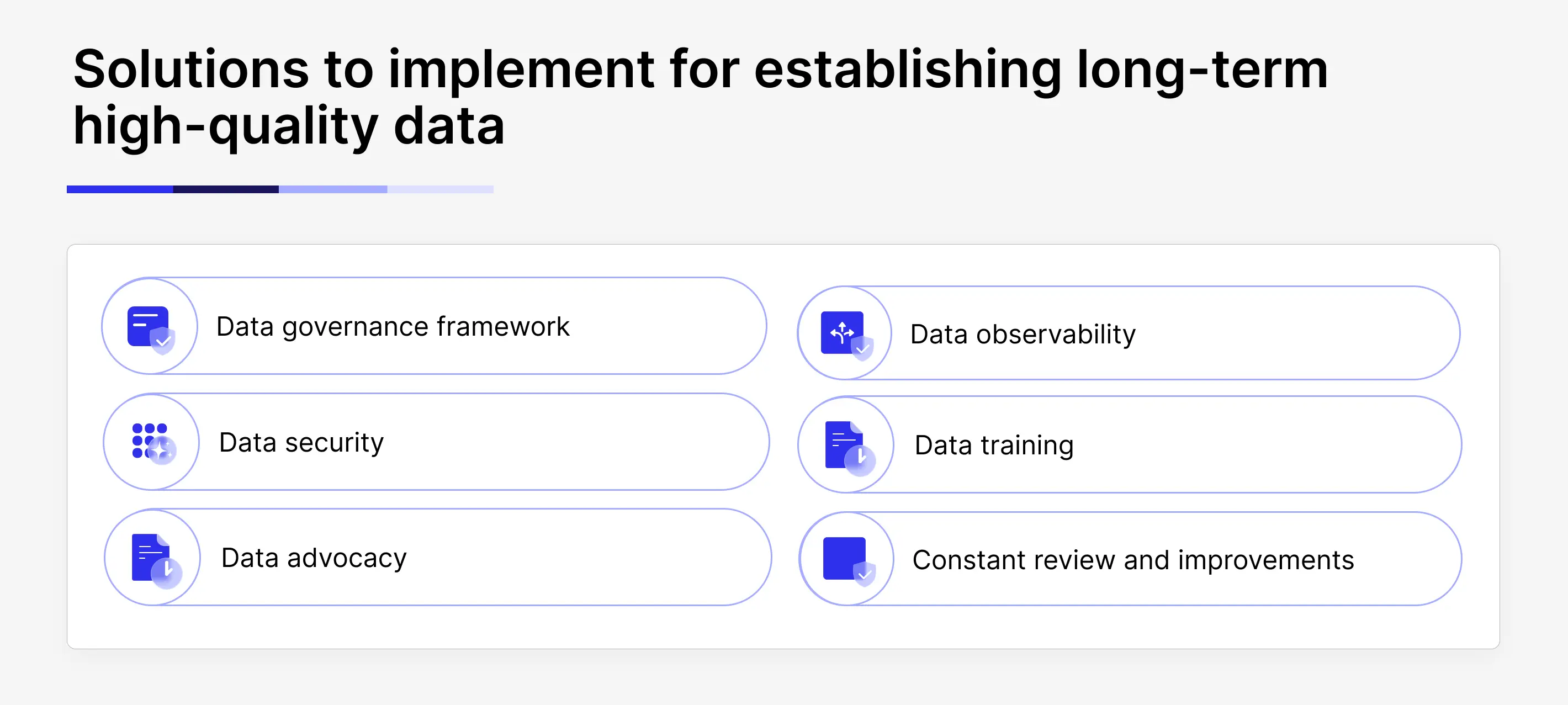Imagine a strategy meeting where the operations lead presents one set of figures, finance offers another, and the CEO is left in decision paralysis. This scenario is all too common in companies struggling with low-trust data — data that employees don’t feel confident using.
Sometimes the numbers come from different systems that don’t synchronize. In some situations, the data is entered incorrectly, by mistake or, in rare instances, intentionally. Ultimately, the lack of trust typically results from poor data quality, when your data does not adhere to the six essential standards: current, complete, clean, consistent, credible, and compliant.
To support confident decision-making, data must reflect the most recent information. It should also be complete, capturing all critical details, and clean, free from errors and duplicates. Consistency matters too: data needs to align across departments and their systems. Just as important is credibility — the data must come from trusted, verifiable sources. And finally, it must comply with industry regulations and standards.
Often, organizations assume — mistakenly — that low-trust data is solely the responsibility of the IT department. Sure, the technical team manages the infrastructure: databases, integration, and tools. But ask any data specialist, and they will tell you the same thing: “It isn’t just a technical problem, it’s a business problem.”
In this article, we’ll explain how to identify low-trust data and offer both immediate and long-term solutions to address it.
How to identify low-trust data: checklist
The good news is that low-trust data doesn’t hide for long; there are clear warning signs you can watch for:

- Frequent data debates during meetings. Whenever numbers are presented, the discussion shifts to: “Where did that figure come from? Our report shows a different result.” It’s a clear red flag — leadership meetings spend more time validating data than actually using it.
- Multiple versions of the truth. Different departments produce conflicting reports on what should be the same metric. Consequently, people start keeping private Excel files because they only trust their calculations due to this inconsistency.
- Excessive manual data checking. Teams often spend a considerable amount of time manually verifying data across different systems.Employees may download records from System A and System B, then compare the two to determine which one is correct.
- Surprise errors and fire drills. Reports often contain obvious errors or outliers that catch leaders off guard, such as KPI suddenly doubling or dropping to zero.
- Low analytics adoption. Even with modern tools in place, many employees still rely on old-school methods, often because experience has shown dashboards to be inaccurate or outdated.
If two or more of these signs sound familiar, it’s time to take action: Every year, businesses lose $12.9 million because of poor data quality, according to Gartner.

Source: Gartner
Where does low-trust data come from?
The first move in fixing low-trust data — though it may feel counterintuitive — is to step back and understand where the root causes lie. Data quality stands on three fundamental pillars: people, technology, and process.

The human aspect is a simple yet often overlooked cause of low-trust data. Take, for instance, everyday errors: someone might enter an invalid client name or forget to enter data altogether. Then there’s the lack of proper data training. These factors are closely tied to a broader issue — the data accountability gap. When no one is responsible for the data, issues go unresolved or get passed from team to team. And the financial impact is real. In 2020, Citigroup (Citi), for example, was fined $400 million by U.S. bank regulators for “ongoing deficiencies,” including weakness in data quality management.
Or could one of the causes be multiple data silos, part of the technology pillar? These are separate, isolated collections of data that aren’t integrated across teams. Sales, finance, and operations might each have their version of the numbers, leading to constant debates over which one is accurate. As a result, it becomes difficult to establish a single source of truth — a reliable platform everyone can use to access consistent, accurate, and up-to-date data.
That was exactly the challenge faced by one of our clients, a private investment company operating in the agricultural sector. They were collecting valuable data from multiple sources, but without a centralized platform, it remained fragmented and unused. After partnering with Sombra to implement a unified data solution, they not only built a high-trust data culture but also achieved a 70% increase in customer satisfaction.
Of course, data silos are only part of the problem. Process flaws, the third pillar of data quality, also play a major role. These include the absence of agreed-upon data standards or a lack of established rules and policies. In fact, Gartner predicts that by 2027, 60% of organizations will struggle to capture the expected value from their AI initiatives because of weaknesses in how they manage and govern data.

Source: Gartner
Practical steps to immediately improve data trust
Many people believe that enhancing data quality requires a complicated approach involving costly tools, a large team of data experts, and years to produce results. This is far from the truth. Building data trust can be done iteratively, and from what we’ve seen with our clients, even the smallest steps can make a big difference.

- Assign Data Ownership. The first step is to identify key data domains in your organization and assign responsibility for each. When someone is on point for, say, “customer data accuracy,” issues are more likely to be caught and resolved quickly rather than falling into no-man’s land.
- Run a Basic Data Audit. Review your most critical datasets or reports to spot obvious issues like duplicates, missing values, and out-of-range numbers. These quick checks make data issues visible, and once people see the problem, they’re motivated to solve it.
- Standardize Definitions. Another quick step to building consistency is to gather stakeholders from different teams and agree on common definitions of the top metrics that run your business. For example, decide how “monthly active users” or “gross margin” is calculated and ensure all reports and dashboards use those standard definitions.
- Implement Data Validation Rules. Most systems allow you to block new entries without a valid email address and flag unusually large transactions for review. By catching errors at the point of entry, you keep bad data from even reaching your analytics.
- Communicate Quick Wins. Did the data audit find an easy fix that corrected 5,000 duplicate records? Announce it. Did aligning on KPI definitions save an hour in the last meeting because everyone was on the same page? Celebrate that.
Establishing a high-trust data culture: long-term solutions
Quick wins are great, but lasting change requires long-term commitment. Here are the key pillars for sustaining it.

Data governance framework
When our clients hear about the need to implement a data governance framework, their first question is whether it will slow things down. That’s a valid concern: some frameworks can be overly document-heavy or have too many layers of approval.
However, our data specialists always recommend keeping things simple. At its core, data governance is about ensuring your data is accurate, consistent, and secure so it can support your business goals. And any framework is just a structure to make it possible.
We often explain data governance to our clients using a five-part breakdown from IBM Technology:
- Discovery. Understand what data assets you have. Keep in mind, there may be data you’re not even aware of.
- Classification. Assign data to relevant categories, such as customer data, product data, or internal records.
- Policy. Establish simple and clear guidelines and standards for how data should be handled.
- Rules. Develop mechanisms to enforce your data policies.
- Metadata. Think of it as a label or tag for your data. It tells you what the data is, where it came from, and how it should be used.
Data security
While data security is a component of data governance, it deserves separate mention. Many companies associate it primarily with protection against breaches, and that’s certainly a crucial part. But data security also means protecting data throughout the organization.
That means preventing unauthorized access and making sure only the right people can view or update sensitive information. It’s also about protecting against data loss, handling encryption keys the right way, and staying in control of where your data lives and how it moves. At Sombra, we help organizations build a secure data infrastructure to ensure compliance with industry standards.
Data advocacy
To change a low-trust data culture, there must be an executive sponsor within the leadership team. As experts explain, this person promotes the value of data initiatives, communicates their benefits, and shares successful milestones along the way. Depending on the size of your organization, you should also have a data governance lead to manage implementation at the tactical level.
Some companies even establish a Data Governance Council. It’s a cross-functional group of executive sponsors and senior leaders from key departments, whose role is to manage data-related goals and ensure consistent execution. This may involve establishing data quality KPIs during performance reviews or encouraging data-driven questions in meetings to emphasize that decisions should rely on facts rather than assumptions.
Data observability
Just as modern factories use sensors and dashboards to monitor equipment, data environments need observation. This involves setting up automated monitoring of your data pipelines and databases to detect anomalies or quality issues.
For instance, if a daily sales feed usually delivers 50,000 records but suddenly drops to 5,000, the system should send an alert. If the distribution of values in a field changes significantly, it should be flagged. AI and ML-powered tools can continuously monitor data health to catch issues early.
Data training
Invest in training to raise data literacy across the organization. While not everyone needs to be a data scientist, all employees should understand data quality basics. Training is crucial for data stewards and analysts as it equips them with the necessary skills to effectively use governance tools, perform quality checks, and analyze data.
Periodic reviews and improvements
Make regular data quality reviews a standard part of your business to catch emerging issues. These reviews typically include checking key datasets for errors, ensuring data policies are being followed, and monitoring changes in data trends that could signal deeper problems.
Gather feedback from data users: Do they trust the data? Are there unmet needs or ongoing pain points? Use this input to update governance priorities. Finally, keep pace with evolving best practices and tools — what worked three years ago might no longer be the best solution.
What you gain by addressing low-trust data
When you overcome low-trust data issues, the four key areas of your organization see the biggest impact:
- Cost reduction. The right approach delivers results quickly: One of our clients, for instance, reduced ongoing data infrastructure costs by 50%. Our data engineers also enabled near real-time data syncing with delays of no more than two minutes, saving the client valuable time.
- Revenue growth. Clean, trusted data enables data-driven decisions, helping both executives and business development teams to see where to focus to maximize results. Just as importantly, it highlights areas where the data is missing so you can spot gaps that hinder decision-making.
- Risk reduction. When your data meets regulatory standards, you reduce the risk of penalties, compliance issues, and data breaches.
- Reputation protection. High-quality data helps you avoid mistakes that can damage your brand’s reputation.
- Innovation enablement. Trusted data forms the foundation for solutions such as AI, predictive analytics, or data-driven personalization.
To trust your data the way you trust your financials or customer relationships, you need a solid foundation. With Sombra, you can implement the changes necessary to turn your data into a true competitive advantage. Contact our experts for a free consultation today.











